Experiments with Perspective
Uccello's
innovative and decorative use of perspective, combined with his flair for
colour, gives his pictures a unique charm that sets them apart from the other
paintings of his time.
In 1481
Cristoforo Landino, a Florentine scholar and philosopher, described Uccello as
a 'good and varied composer, a great master of animals and landscapes and
skilful in foreshortening because he understood perspective well.' Landino was
particularly well-equipped to judge Uccello's painting, for he was a friend and
admirer of Leon Battista Alberti, whose treatise on painting, written in 1435,
contained the earliest account of the principles of linear perspective.
ALBERTI'S SYSTEM
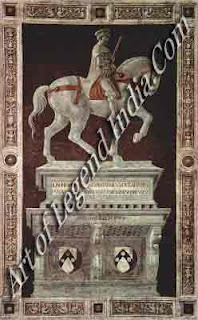 The
principles which Alberti laid down in De Pictura were relatively simple.
Alberti observed that, when we look at the outside world, objects which stand
parallel to our line of vision appear to recede into the distance. Furthermore,
he observed, these parallel lines, or objects, seem to converge towards a
single point somewhere on the horizon. Accordingly, Alberti devised a new
perspective system, known as the costruzione legittima, to show how artists
could reproduce this effect on a flat surface. By constructing the painting
around a grid of converging lines leading to a single 'vanishing point' the
artist could achieve the effect of distance, or recession into space.
The
principles which Alberti laid down in De Pictura were relatively simple.
Alberti observed that, when we look at the outside world, objects which stand
parallel to our line of vision appear to recede into the distance. Furthermore,
he observed, these parallel lines, or objects, seem to converge towards a
single point somewhere on the horizon. Accordingly, Alberti devised a new
perspective system, known as the costruzione legittima, to show how artists
could reproduce this effect on a flat surface. By constructing the painting
around a grid of converging lines leading to a single 'vanishing point' the
artist could achieve the effect of distance, or recession into space.
Uccello
undoubtedly knew about Alberti's ideas, although he was unlikely to have read
De Pictura. During the course of his career he became increasingly interested
in the possibilities of perspective, and exploited it in a number of ingenious
and imaginative ways.
Uccello's
earlier works show little trace of his later fascination with perspective. The
scenes of the Creation and the Fall of Man in the Chiostro Verde (the 'Green
Cloister' in the church of Santa Maria Novella in Florence) are constructed in
a shallow foreground space, marked out by the simple shapes of rocks and trees.
Uccello has made no attempt to suggest a deep or dramatic space, but confines
the action to the front of the picture. The frescoes show most clearly the
continued influence on Uccello of his old master Ghiberti, and Uccello may have
worked in part from drawings which Ghiberti was preparing for the second set of
doors for the Baptistry in Florence.
By the
time he came to paint the monument to Sir John Hawkwood however, Uccello had
clearly begun to explore the possibilities of perspective. In this
commemorative fresco he uses perspective to create the illusion of a solid
sarcophagus projecting out from the surface of the wall. Although the horse and
rider seem relatively flat, the sarcophagus itself, when seen in situ, appears
to be three-dimensional.
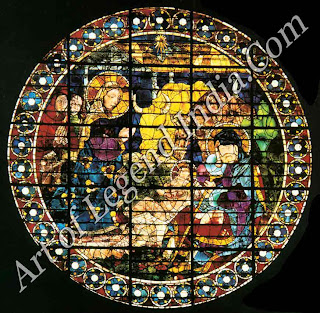 The
formulation of perspective gave artists an unprecedented freedom in depicting
the external world. For Uccello, however, perspective was not simply a means of
creating an apparently realistic space. He realised that it could also be used
to great dramatic effect. This is the most evident in his late fresco The Flood
in the Chiostro Verde (the 'Green Cloister'). This fresco contains two
different but related episodes the Flood on the left and the Recession of the
Waters on the right. Here, the diagonal lines, or orthogonal, in the picture do
not meet at a single vanishing point as Alberti suggested. Instead, each side
of the picture seems to have its own focal point, a device which divides the
fresco clearly into two. At the same time these two slightly different systems or
'constructions' combine to suggest a dramatic plunge into depth, at the end of
which we see a vivid bolt of lightning. By diverging from the strict
rationality of Alberti's system, Uccello could create a slightly distorted
illusion of space which adds to his terrifying vision of the Flood.
The
formulation of perspective gave artists an unprecedented freedom in depicting
the external world. For Uccello, however, perspective was not simply a means of
creating an apparently realistic space. He realised that it could also be used
to great dramatic effect. This is the most evident in his late fresco The Flood
in the Chiostro Verde (the 'Green Cloister'). This fresco contains two
different but related episodes the Flood on the left and the Recession of the
Waters on the right. Here, the diagonal lines, or orthogonal, in the picture do
not meet at a single vanishing point as Alberti suggested. Instead, each side
of the picture seems to have its own focal point, a device which divides the
fresco clearly into two. At the same time these two slightly different systems or
'constructions' combine to suggest a dramatic plunge into depth, at the end of
which we see a vivid bolt of lightning. By diverging from the strict
rationality of Alberti's system, Uccello could create a slightly distorted
illusion of space which adds to his terrifying vision of the Flood.
CAREFUL DRAWINGS
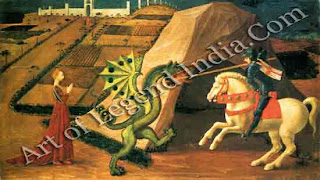 Uccello
did not achieve these effects without careful preparation. For all his frescoes
he used detailed sinopie or under drawings, and in addition it seems likely
that he used cartoons which were pricked through on to the intonaco, the final
layer of plaster. He also made detailed drawings of individual objects seen in
perspective, a few of which have fortunately survived. Some of these may well
have been made for Uccello's own pleasure and instruction but many would have
served as models for use in his paintings.
Uccello
did not achieve these effects without careful preparation. For all his frescoes
he used detailed sinopie or under drawings, and in addition it seems likely
that he used cartoons which were pricked through on to the intonaco, the final
layer of plaster. He also made detailed drawings of individual objects seen in
perspective, a few of which have fortunately survived. Some of these may well
have been made for Uccello's own pleasure and instruction but many would have
served as models for use in his paintings.
These
drawings show particularly clearly how Uccello reduced everything he saw to a
series of geometric shapes. His perspective was not simply a way of
constructing his works. By reducing them to a set of regular forms Uccello
could accommodate figures and objects more easily within the geometric
'construction' and use them to emphasize the underlying grid. By working in
this way, Uccello turned perspective into a kind of decorative scheme. It was
no longer a means of achieving spatial realism, hut a way of creating complex
geometric patterns. It is this imaginative and decorative use of perspective
which makes Uccello's works unique. It sets him apart from the other artists of
his time who were simply using perspective to create the illusion of depth and
three-dimensional reality in a picture.
UNUSUAL COLOURS
In
Uccello's later works this unusual technique is combined with a superbly
original use of colour. In the battle-pieces which he painted for the Medici,
for example, Uccello uses colour as a way of creating attractive patterns
without aiming to be strictly realistic. Later critics found it hard to
appreciate this aspect of Uccello's style. When describing Uccello's frescoes
at San Miniato, Vasari complained that the artist had 'made the fields blue,
the cities red and the buildings in various colours as he felt inclined.' For
the 15th-century observer, however, this distinctive and witty use of colour
clearly added to the gaiety and charm which gives Uccello's paintings their
lasting appeal.
Writer
– Marshall Cavendish
 The
principles which Alberti laid down in De Pictura were relatively simple.
Alberti observed that, when we look at the outside world, objects which stand
parallel to our line of vision appear to recede into the distance. Furthermore,
he observed, these parallel lines, or objects, seem to converge towards a
single point somewhere on the horizon. Accordingly, Alberti devised a new
perspective system, known as the costruzione legittima, to show how artists
could reproduce this effect on a flat surface. By constructing the painting
around a grid of converging lines leading to a single 'vanishing point' the
artist could achieve the effect of distance, or recession into space.
The
principles which Alberti laid down in De Pictura were relatively simple.
Alberti observed that, when we look at the outside world, objects which stand
parallel to our line of vision appear to recede into the distance. Furthermore,
he observed, these parallel lines, or objects, seem to converge towards a
single point somewhere on the horizon. Accordingly, Alberti devised a new
perspective system, known as the costruzione legittima, to show how artists
could reproduce this effect on a flat surface. By constructing the painting
around a grid of converging lines leading to a single 'vanishing point' the
artist could achieve the effect of distance, or recession into space.  The
formulation of perspective gave artists an unprecedented freedom in depicting
the external world. For Uccello, however, perspective was not simply a means of
creating an apparently realistic space. He realised that it could also be used
to great dramatic effect. This is the most evident in his late fresco The Flood
in the Chiostro Verde (the 'Green Cloister'). This fresco contains two
different but related episodes the Flood on the left and the Recession of the
Waters on the right. Here, the diagonal lines, or orthogonal, in the picture do
not meet at a single vanishing point as Alberti suggested. Instead, each side
of the picture seems to have its own focal point, a device which divides the
fresco clearly into two. At the same time these two slightly different systems or
'constructions' combine to suggest a dramatic plunge into depth, at the end of
which we see a vivid bolt of lightning. By diverging from the strict
rationality of Alberti's system, Uccello could create a slightly distorted
illusion of space which adds to his terrifying vision of the Flood.
The
formulation of perspective gave artists an unprecedented freedom in depicting
the external world. For Uccello, however, perspective was not simply a means of
creating an apparently realistic space. He realised that it could also be used
to great dramatic effect. This is the most evident in his late fresco The Flood
in the Chiostro Verde (the 'Green Cloister'). This fresco contains two
different but related episodes the Flood on the left and the Recession of the
Waters on the right. Here, the diagonal lines, or orthogonal, in the picture do
not meet at a single vanishing point as Alberti suggested. Instead, each side
of the picture seems to have its own focal point, a device which divides the
fresco clearly into two. At the same time these two slightly different systems or
'constructions' combine to suggest a dramatic plunge into depth, at the end of
which we see a vivid bolt of lightning. By diverging from the strict
rationality of Alberti's system, Uccello could create a slightly distorted
illusion of space which adds to his terrifying vision of the Flood.  Uccello
did not achieve these effects without careful preparation. For all his frescoes
he used detailed sinopie or under drawings, and in addition it seems likely
that he used cartoons which were pricked through on to the intonaco, the final
layer of plaster. He also made detailed drawings of individual objects seen in
perspective, a few of which have fortunately survived. Some of these may well
have been made for Uccello's own pleasure and instruction but many would have
served as models for use in his paintings.
Uccello
did not achieve these effects without careful preparation. For all his frescoes
he used detailed sinopie or under drawings, and in addition it seems likely
that he used cartoons which were pricked through on to the intonaco, the final
layer of plaster. He also made detailed drawings of individual objects seen in
perspective, a few of which have fortunately survived. Some of these may well
have been made for Uccello's own pleasure and instruction but many would have
served as models for use in his paintings. 
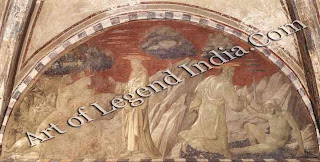
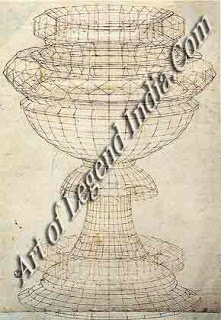










0 Response to "Italian Great Artist Paolo Uccello - Experiments with Perspective "
Post a Comment